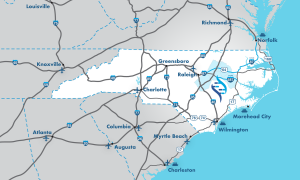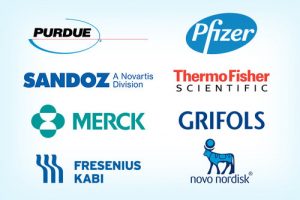 As we all grapple with the threat of COVID-19, some of our public power communities are uniquely primed to help. North Carolina is home to a prolific life science industry, including in the BioPharma Crescent in the east. A national effort to re-shore U.S. pharmaceutical manufacturing could have significant economic and public health benefits — and our local communities are ready to support ramped-up domestic production of supplies, medicines, and more.
As we all grapple with the threat of COVID-19, some of our public power communities are uniquely primed to help. North Carolina is home to a prolific life science industry, including in the BioPharma Crescent in the east. A national effort to re-shore U.S. pharmaceutical manufacturing could have significant economic and public health benefits — and our local communities are ready to support ramped-up domestic production of supplies, medicines, and more.
 The BioPharma Crescent comprises Edgecombe, Johnston, Nash, Pitt, and Wilson counties, including the public power communities of Clayton, Greenville, Rocky Mount, and Wilson. The area has 50 years of pharmaceutical production history and a recent spike in development over the past few years. Biopharma has been creating thousands of opportunities for residents across the region and spurred more than $3 billion of investments.
The BioPharma Crescent comprises Edgecombe, Johnston, Nash, Pitt, and Wilson counties, including the public power communities of Clayton, Greenville, Rocky Mount, and Wilson. The area has 50 years of pharmaceutical production history and a recent spike in development over the past few years. Biopharma has been creating thousands of opportunities for residents across the region and spurred more than $3 billion of investments.
Now, as the industry focuses on responding to the new coronavirus, it’s revisiting its supply chain. Last year, pharmaceuticals were the third largest national import category, behind automobiles and crude oil. Even many of the ingredients that make up pharmaceutical drugs are imported; three major antibiotics used to treat coronavirus or related infections are dependent on supplies from outside of the U.S. Given the uncertain international climate, revitalizing domestic manufacturing creates a valuable and reliable supply chain for these crucial drugs.
While a major market shift won’t happen quickly, every little bit will help. Regions like the BioPharma Crescent provide vital cost-effective business environments to help pharma companies re-grow their U.S. manufacturing — and quickly.
 Companies including Novo Nordisk, Pfizer, Merck, Grifols, Purdue, and Thermo-Fisher Scientific are among the major pharmaceutical manufacturing companies with facilities across the BioPharma Crescent. To spur continued growth, officials of each county are united, sharing workforce and resources. That united front is now more important than ever, transforming these public power communities into key locations in the fight against the virus.
Companies including Novo Nordisk, Pfizer, Merck, Grifols, Purdue, and Thermo-Fisher Scientific are among the major pharmaceutical manufacturing companies with facilities across the BioPharma Crescent. To spur continued growth, officials of each county are united, sharing workforce and resources. That united front is now more important than ever, transforming these public power communities into key locations in the fight against the virus.
